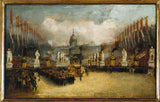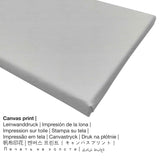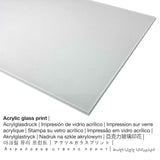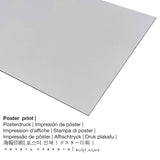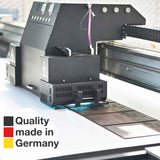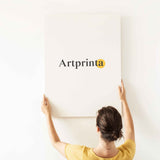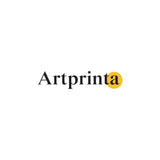Amaghị aha, 1840 - Ọbịbịa nke ntụ Napoleon na Esplanade des Invalides, Disemba 15, 1840. - ọmarịcha nka nka.
Ụtụ gụnyere. Mbupu gbakọrọ na ndenye ọpụpụ.
Họrọ nhọrọ ihe ebipụta nka
Anyị na-enye ụdị nha na ihe dị iche iche maka ngwaahịa ọ bụla. Nhọrọ ndị a dị maka n'otu n'otu:
- Mbipụta iko acrylic (nke nwere ezigbo mkpuchi iko): A glossy acrylic glass print, often referred to as a print on plexiglass, will turn the original into great décor and is a great alternative option to canvas or aluminium dibond art prints. The major advantage of an acrylic glass fine art copy is that sharp contrasts and small color details will be more visible with the help of the fine tonal gradation in the print.
- Mbipụta nke aluminom: An Aluminium Dibond print is a print material with an outstanding depth effect, which creates a fashionable look with a non-reflective surface. A direct Direct Print on Aluminum Dibond is your best introduction to fine reproductions on aluminum. The colors of the print are luminous in the highest definition, fine details are clear and crisp.
- Poster (akwa akwa akwa): The poster print is a UV printed sheet of canvas with a granular surface structure. Please note, that depending on the size of the canvas poster print we add a white margin between 2-6cm round about the print, which facilitates the framing.
- Mbipụta kwaaji: The canvas print, not to be mistaken with a painting on a canvas, is a digital replica printed on a cotton canvas material. It produces the extra impression of three-dimensionality. A printed canvas of this artpiece will allow you to transform your into a large artpiece like you know from galleries. How do I hang a canvas print on my wall? Canvas prints are relatively low in weight, which implies that it is quite simple to hang your Canvas print without the help of extra wall-mounts. A canvas print is suitable for any type of wall.
Nkwupụta iwu: We try all that we can to depict the art products as precisely as possible and to showcase them visually in our shop. Still, the colors of the print products and the print result might differ to a certain extent from the image on the monitor. Depending on the screen settings and the nature of the surface, not all colors will be printed one hundret percent realistically. Since our art prints are processed and printed by hand, there might as well be slight variations in the motif's size and exact position.
Nkọwapụta nka sitere na webụsaịtị ihe ngosi nka (© - nke Musée Carnavalet Paris dere - Ụlọ ihe nkiri Carnavalet Paris)
From either side of the plaza were installed grandstands before which were erected monumental plaster statues of great military.
The body of Napoleon, brought to France by the Prince de Joinville, had arrived in Courbevoie, after ascending the Seine from Le Havre on 14 December 1840. The next day a long procession around the monumental chariot, left the morning of Neuilly, climbed up to the Star, down the Champs Elysees to the Place de la Concorde, across the Seine and the Invalides arrived around 13:30. All along the route, a prodigious crowd followed the ceremony.
Onyinye ngwaahịa nka
"Arrival of Napoleon's ashes on the Esplanade des Invalides, December 15, 1840." is an artwork made by the painter Anonymous. The 180 year old version of the work of art has the following size Height: 28,7 cm, Width: 41,1 cm, Thickness: 3,5 cm and was painted with the techinque Agba mmanụ. What is more, this piece of art is in the the digital art collection of Musée Carnavalet Paris in Paris, France. This modern art work of art, which is in the ngalaba ọha a na-enye ya site n'ikike nke Ụlọ ihe nkiri Carnavalet Paris.Ihe kredit nke ọrụ nka bụ: . Ndozi n'ime odida obodo format ya na oke onyonyo nke 3: 2, nke pụtara na ogologo bụ 50% ogologo karịa obosara.
Tebụl ihe osise
| Aha ọrụ nka: | "Arrival of Napoleon's ashes on the Esplanade des Invalides, December 15, 1840." |
| nhazi ọkwa: | sere |
| Otu sara mbara: | nkà nke oge a |
| Nhazi oge: | 19th narị afọ |
| Emepụtara na: | 1840 |
| Ogologo afọ nka nka: | ihe dị ka afọ 180 |
| Usoro nka izizi: | Agba mmanụ |
| Ogo nke ọrụ nka izizi: | Ogologo: 28,7 cm, obosara: 41,1 cm, ọkpụrụkpụ: 3,5 cm |
| Ụlọ ihe ngosi nka / ebe: | Ụlọ ihe nkiri Carnavalet Paris |
| Ebe ngosi nka: | Paris, France |
| Weebụsaịtị ihe ngosi nka: | Ụlọ ihe nkiri Carnavalet Paris |
| Licensedị ikike: | ngalaba ọha |
| Site n'aka: | Ụlọ ihe nkiri Carnavalet Paris |
Nkọwapụta ngwaahịa
| Nkewa ngwaahịa: | ezi nka mmeputakwa |
| Mmeputakwa: | dijitalụ mmeputakwa |
| Usoro mmepụta: | Mbipụta UV / dijitalụ |
| Production: | arụpụtara na Germany |
| Ụdị ngwaahịa: | a na-achọ |
| Eji ngwaahịa emebere: | mgbidi mgbidi, mgbidi ịchọ mma |
| Nhazi: | nhazi odida obodo |
| Oke akụkụ onyonyo: | 3:2- (ogologo: obosara) |
| Ntụgharị nkọwa akụkụ onyonyo: | ogologo bụ 50% ogologo karịa obosara |
| Ihe mmeputakwa dị: | ígwè obibi akwụkwọ (aluminium dibond), akwụkwọ mmado (akwụkwọ kwaaji), mbipụta enyo acrylic (nke nwere ezigbo mkpuchi iko), mbipụta akwụkwọ. |
| Nhọrọ nke Canvas Mbipụta (akwa akwa na etiti ihe ndọtị): | 30x20cm - 12x8", 60x40cm - 24x16", 90x60cm - 35x24", 120x80cm - 47x31", 150x100cm - 59x39" |
| Acrylic glass print (nwere ezigbo mkpuchi iko) nhọrọ: | 30x20cm - 12x8", 60x40cm - 24x16", 90x60cm - 35x24", 120x80cm - 47x31", 150x100cm - 59x39" |
| Ụdị akwụkwọ mmado (akwụkwọ kwaaji) dị iche iche: | 60x40cm - 24x16", 90x60cm - 35x24", 120x80cm - 47x31" |
| Mpempe akwụkwọ Dibony (ihe alumnium) nha: | 30x20cm - 12x8", 60x40cm - 24x16", 90x60cm - 35x24", 120x80cm - 47x31" |
| Igwe onyonyo: | enweghị etiti |
Nkọwa onye nka
| aha: | amaonye |
| Ọrụ nke onye na-ese ihe: | onye na-ese ihe |
| Nhazi nke onye nka: | omenkà nke oge a |
© Copyright - ikike ọgụgụ isi nke | Artprinta.com

